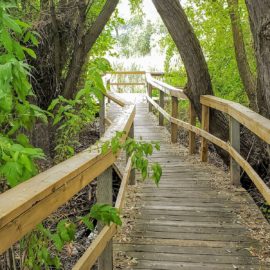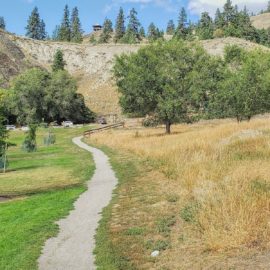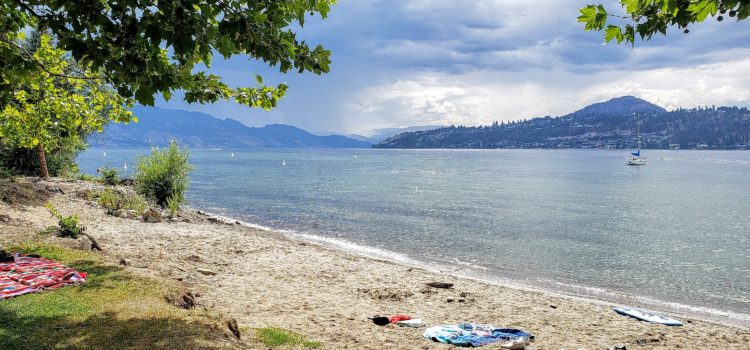
Kelowna Parks Challenge Trip #4
After a false start, I completed another adventure exploring the parks of Kelowna as part of my Kelowna Parks Challenge. This time I went for more low-hanging fruit, visiting a string of lakeshore parks running south from Downtown to South Pandosy. Including City Park, I visited thirteen parks, so I have divided the trip into two posts. In this first part, I’ll talk about Rowcliffe Park, City Park, and five beach access parks: Lake Avenue, McTavish Avenue, Vimy Avenue, Beach Avenue, and Burne Avenue. Read on for my impressions and reflections
Rowcliffe Park
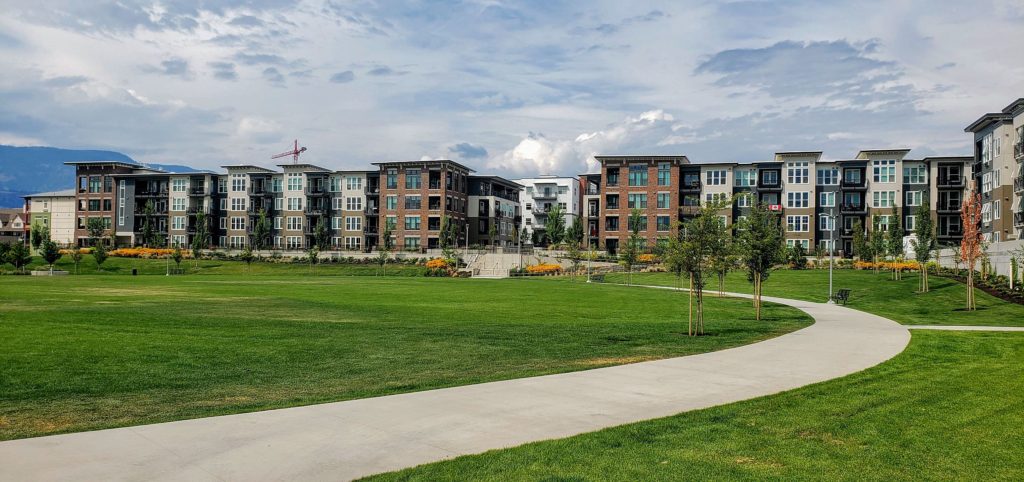
Once again I set out with my wonderful wife Jen. It took us two attempts to complete this trip. On the first day, the only park we got to was the first on the route: Rowcliffe Park.
This is a new park that is currently being developed on the former site of Kelowna Secondary School. Thanks to being designed at the same time as the condos that occupy the rest of the former high school land, the park’s northern edge has been integrated with them.

Two of the three phases of development are finished. All that’s left is the streetside border. Inside the park, there is a fenced-in dog park, a children’s playground, and a community garden. There is also a 350-metre circular walking path surrounding a large lawn (111 metres across if my high school math skills aren’t letting me down). I know wide lawns are useful for staging large-scale sports and games, but they’re not my favourite thing to view when walking for pleasure.
My favourite part of this new park was probably the oldest. In the southeast corner, there is a large tree, which has obviously been growing there a long time. I am glad the city decided to retain this heritage feature.
Washrooms and Drinking Fountains: There is no washroom in this park, but there is a drinking fountain. It is at the end of the promenade that enters the park from the southeast, next to the dog park.
Dog Rules: Dogs are allowed off-leash in the fenced-in dog park on the south side of the park.
City Park (the rest)
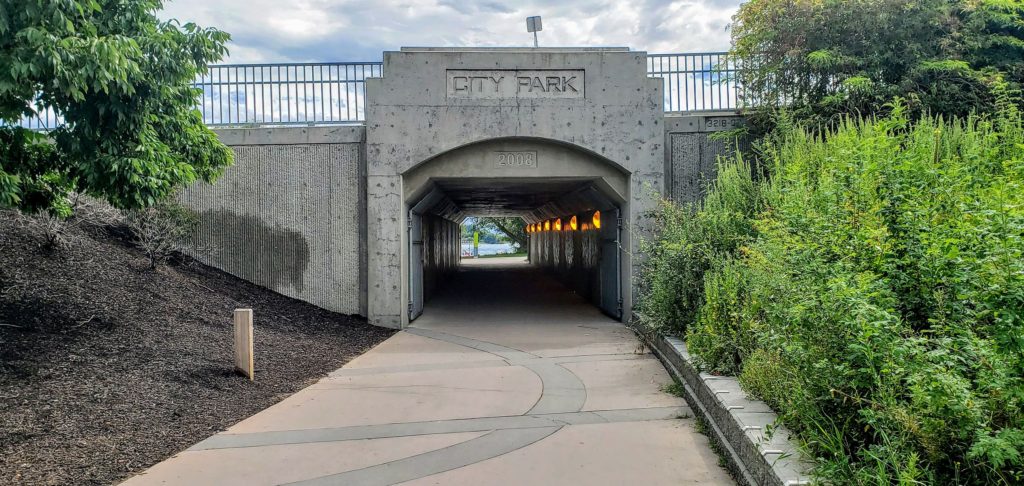
After making our way west, roughly following Mill Creek, to the intersection of Water Street and Harvey Avenue, we had to abandon our walk, but picked it up a couple of days later in the southern part of City Park.
I visited City Park in Kelowna Parks Challenge Trip #1 but didn’t get farther south than the basketball and beach volleyball courts. Not knowing how much more there was to see, I marked the park as ‘incomplete’. This trip I saw the rest.
The rest of City Park comprises a tunnel under the highway and a strip of land south of the highway, on the right bank of Mill Creek. Up by the highway, there is a rough plaza with a number of red girders artfully arranged, which I took to be another monument to the original Okanagan Lake Bridge.
Washrooms and Drinking Fountains: As I posted before, there are two sets of washrooms in City Park, one by the water park and the other by the basketball courts. There are also three drinking fountains, one near the entrance from Kerry Park, one near the skate park, and one near the basketball courts.
Dog Rules: Though dogs are permitted on-leash in this park, they are only permitted on paths and sidewalks. They are not allowed on lawns or beaches.
Lake Avenue Beach Access
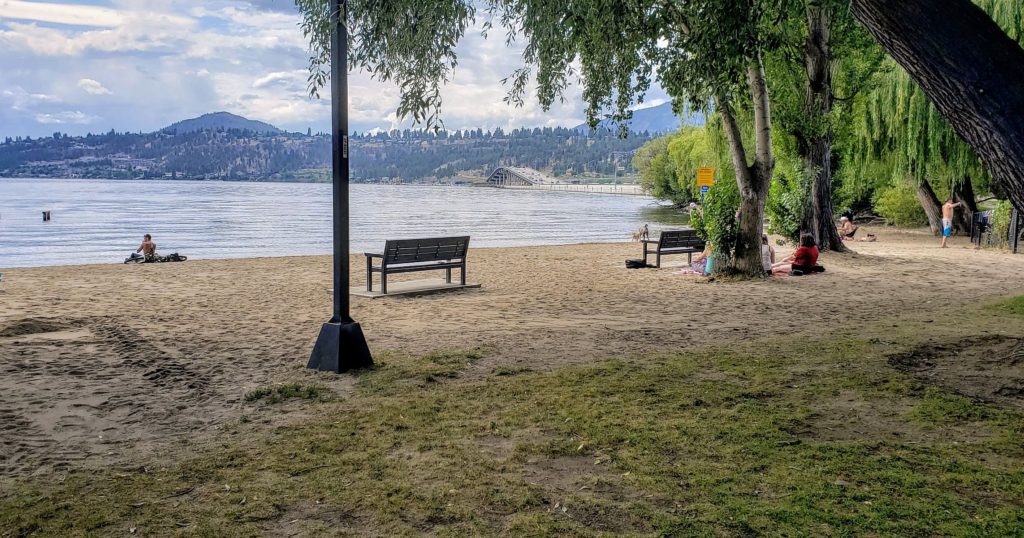
Crossing Mill Creek by bridge we came to the first of the beach access parks we visited on this trip. Though they were all similar, they had their differences. This first beach, at the end of Lake Avenue, is distinguished by the presence of the mouth of Mill Creek.
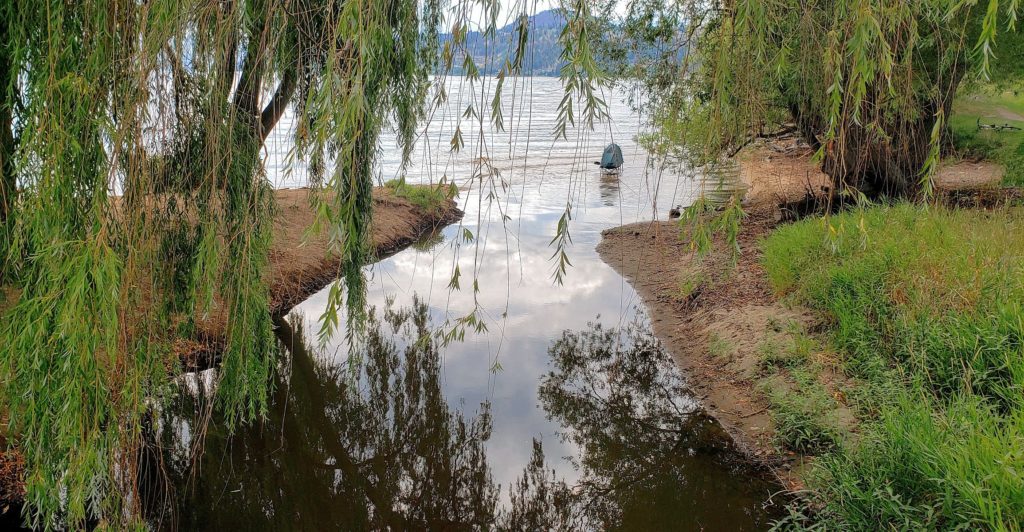
Though it has carried much water from high in the eastern mountains, through the heart of the city, sometimes protected, sometimes disrespected, its mouth is more cute than colossal. No powerful current has dug any deep channel here. During our visit, someone had planted a covered beach chair right in the middle of the cool effluence, in the shade of the willows.
Washrooms and Drinking Fountains: Unexpectedly, there is a washroom here. It is of the portable variety, but sits on a small concrete slab, so I assume it is relatively permanent.
Dog Rules: This is a beach, so no dogs are allowed.
McTavish Avenue Beach Access
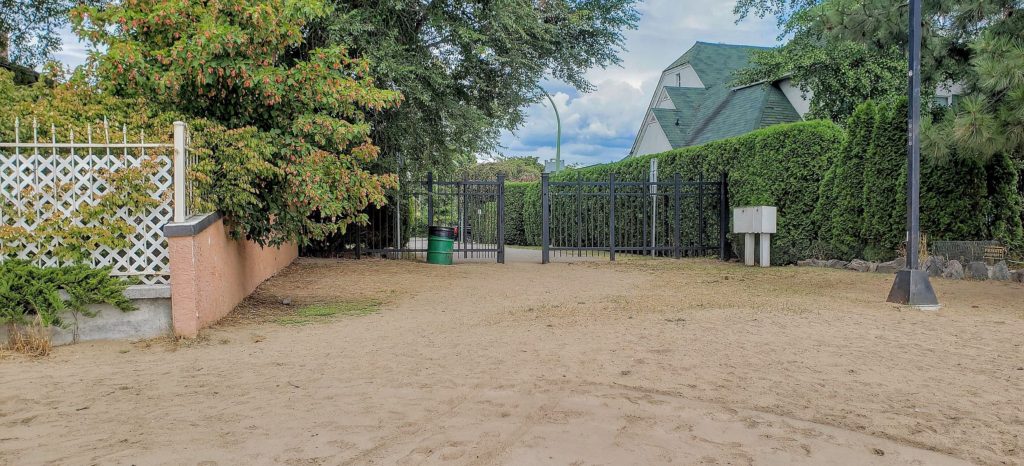
This park is connected to Lake Avenue Beach Access by a strip of beach. Unlike several other sandy connections between several other beach parks, this stretch is actually official parkland. To the south, the beaches are private property, at least the parts that lie above the high-water mark. I don’t think that stops a lot of people from walking there, though.
Other than the beach, this park lacked in features and felt like not much more than a simple access point. Not that that doesn’t have immense value. From this point south, we were in the Abbott Heritage Conservation Area. Properties here, especially along the water, are incredibly valuable. Free beach access for citizens here is worth a great deal.
Washrooms and Drinking Fountains: There are no washrooms or drinking fountains in this park.
Dog Rules: This is a beach, so no dogs are allowed.
Vimy Avenue Beach Access
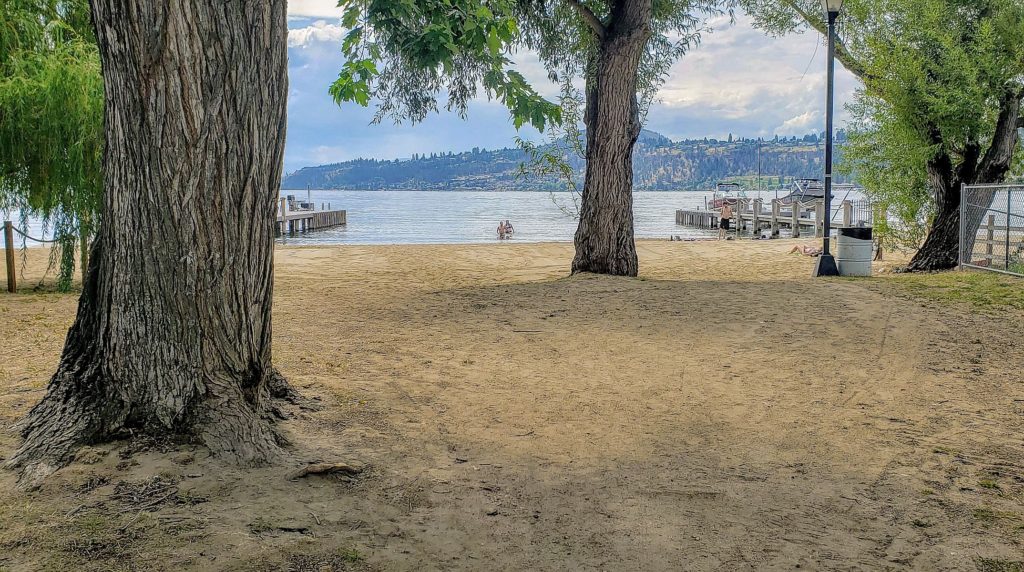
This beach is another beautiful place to spend some time in the water. As I mentioned above, it is connected by sand to McTavish Avenue Beach Access, and a bolder person than I could easily walk along the water from one to the other either in defiance or ignorance of the law. Given the number of footsteps in the sand, such behaviour appears customary.
Washrooms and Drinking Fountains: There are no washrooms or drinking fountains in this park.
Dog Rules: This is a beach, so no dogs are allowed.
Beach Avenue Beach Access
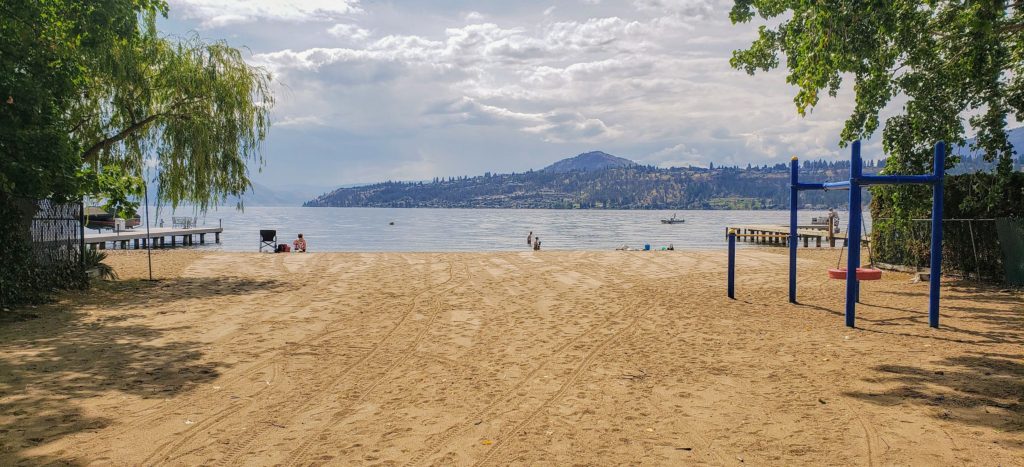
You’d think, given its name, that this park would have a little extra. Seriously, though, the extra here is a playground and a picnic table. Like the last park, Vimy Avenue Beach Access, this park has two large black cottonwood trees. It was wonderful to see how large those trees grow here.
Washrooms and Drinking Fountains: There are no washrooms or drinking fountains in this park.
Dog Rules: This is a beach, so no dogs are allowed.
Burne Avenue Beach Access
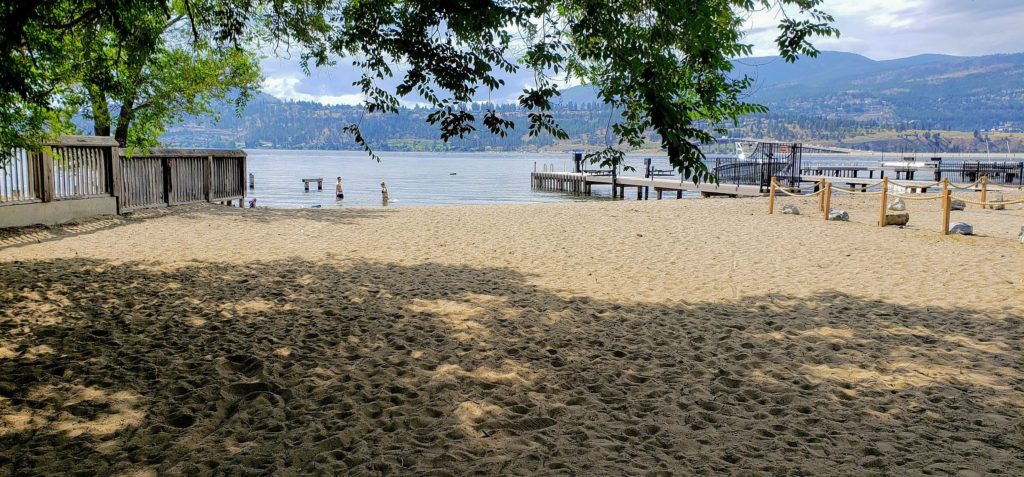
This beach is the southernmost of those parks that are strung together by an unbroken stretch of sand. As you can see from the photo above, the southern border of the park is lined by a fence that extends right to the water’s edge, if not beyond.
This park does not have a playground or picnic table, but it does have a solid bench with a garbage can. These features may be common, but they were welcome additions for walkers like us, with loads to take off and snacks to eat.
Washrooms and Drinking Fountains: There are no washrooms or drinking fountains in this park.
Dog Rules: This is a beach, so no dogs are allowed.
To be continued…
After this, we continued our walk, travelling to Cadder Avenue Beach Access and on to West Avenue Beach Access. I have mentioned enough beach accesses for one post, however, and will talk about the rest of the trip in my next post.
Reflections
Beach Accesses
In Kelowna, the parks department has clearly for many decades had a policy of facilitating access to the beach for all citizens. Now that almost all of the local lakeshore has been converted to residential retaining walls and pleasant sandy beaches instead of its original configuration of environmentally invaluable marshland, there is much of it to go around.
As near as I can tell, every east/west running avenue that runs into the lake terminates in a beach access park. I think this is great. There are obviously enough because most of those we visited were not busy. Even surrounded by million-dollar heritage mansions, these are places where the poorest people can enjoy the priceless pleasures of the beach.
Walking Along the Shoreline
As I mentioned in my descriptions, beach access parks do not represent the only opportunity walkers have to access the beach. By law, any land below the high-water mark is public property, unless someone has a special lease, which they have to let you know about with signs. In other words, despite any landscaping choices that might suggest otherwise, anyone is allowed to walk along the waterline in front of any mansions or other properties that might be adjacent.
The people who live along the lake clearly know this, because in most cases on this trip we saw ‘Private Property’ signs all over the entrances to private docks, but not blocking the beach. There were some areas where fences had been built to extend beyond the high-water mark, and I need to do more research before I know where local people stand on that question.
Natural Variation
It is undeniable that all of the beach access parks we visited on this trip were very similar. Though the flavour of each varied slightly, all of them were equally well-suited to a lazy day at the beach. At any one of them, a visitor could lie equally well on the sand, or go for a swim in the lovely lakewater. As a walker, however, I enjoyed the experience of visiting a string of them and observing the subtle shifting of geographical perspective.
Firstly, I noticed that the beach access parks in the northern part of our route, the part described in this post, had shallower beaches. In next week’s post, I will describe parks where the bottom dropped away more quickly.
Secondly, I particularly enjoyed the variation in the views of Mount Boucherie and Squally Point as we travelled south along the lakeshore. The point, in particular, was not visible until we got south of Strathcona Park, and it was fun to see it emerge, bit by bit.
Wildlife
Not a lot of wildlife this time, though I did spot quail again. As we were walking between Vimy Avenue Beach Access and Beach Avenue Beach Access, we spotted a quail couple darting across an unfinished residential lawn. I had thought, since their powers of flight appear limited, these birds would not be so abundant in the heart of the city, but it seems they like suburban areas just fine, no matter how far from the surrounding wilderness.
Challenge Check-In
With the addition of the twelve new parks from this trip, I have now seen twenty-six of the 203 parks on the Official List, or almost thirteen percent. Six percent of the year has passed, so even though I added a lot of parks this trip, I haven’t actually improved my pace much over the last time I checked in.
I am well aware that at my current pace I will finish this challenge in half the time I set for myself. I’m still not sure it will be as easy as that, however. As I mentioned at the top of this post, I am still picking the low-hanging fruit. All of the parks I have visited so far have been near Downtown, for example. On this trip, I intentionally chose my route to check off a lot of densely-packed parks in one day. The only ‘outlier’ was Rowcliffe Park. I also wanted to visit the beaches in the summer.
I still think my pace will slow in the winter and as I have to travel further afield to visit harder-to-reach parks.
Conclusion
It was fun to walk from beach to beach, exploring the lakefront. With a beach access park nearly every block, it hardly takes five minutes to walk from one park to another. If it hadn’t been time to close the loop and head home for dinner, we felt we could have continued on and seen many more.
I hope you enjoyed learning about the parks visited on this trip. Please comment if you love any of the parks I mentioned or know anything special about them or their history.
Keep your eyes out for my next post, where I will describe the second half of our trip, from Cadder Avenue Beach Access to West Avenue Beach Access, including a visit to the breathtaking Roxby Marsh.


